Speak directly to the analyst to clarify any post sales queries you may have.
Senior leaders in the red beaten rice market face heightened complexity from evolving consumer demands, regulatory shifts, and growing pressure for sustainable supply chain practices. In this environment, adaptable strategy and risk mitigation are essential for sustainable growth and operational strength.
Market Snapshot: Red Beaten Rice Market Size and Growth Outlook
The global red beaten rice market is valued at USD 244.98 million and expected to reach USD 259.59 million within the year, reflecting a compound annual growth rate of 5.89%. This market expansion is fueled by rising interest in nutritional rice alternatives that address both health and sustainability concerns. Organizations are sharpening their competitiveness by strengthening supply chains, enhancing compliance readiness, and pursuing cost efficiency in anticipation of fast-changing consumer sentiment. Differentiated brand positioning and optimized operating models are fundamental as companies navigate the sector’s dynamic, price-conscious landscape.
Scope & Segmentation: Executive-Level Insights for the Red Beaten Rice Market
Detailed segmentation enables senior decision-makers to direct investment, drive innovation, and tailor market entry or expansion strategies. Each dimension is designed to target specific buyer needs and emerging consumption patterns for the red beaten rice market.
- Product Attribute: Nutritional-focused options—such as fortified or organic—draw interest from health-driven segments; clean label products fulfill transparency expectations; heritage varieties serve consumers pursuing authenticity and tradition.
- Packaging Type: Bulk solutions meet institutional procurement standards, while smaller packets are optimized for retail appeal and consumer convenience.
- Application: The product serves diverse channels, including foodservice environments like hotels and bakeries as well as domestic consumers prioritizing nutrition and ease of preparation.
- Product Type: Portfolios feature parboiled rice, known for its stability in transport, alongside steam-processed types suitable for premium and artisanal positioning.
- Distribution Channel: Strategic options include digital platforms for operational streamlining, mass retail to broaden reach, and specialty outlets that target defined niche audiences—all supported by technology-enabled process transparency and measurement.
- Regional Coverage: Targeted approaches for areas such as the Americas, Europe, Asia-Pacific, and Middle East & Africa align with the regulatory and growth landscapes unique to each region, ensuring market-specific compliance and opportunity capture.
- Leading Companies: Sector benchmarks are set by companies including Capital Foods Ltd, Haldiram Snacks Pvt Ltd, Patanjali Ayurved Ltd, Tata Consumer Products Ltd, ITC Ltd, LT Foods Ltd, Conscious Food Ltd, Bikanervala Foods Pvt Ltd, Deep Foods Inc., and Organic India Pvt Ltd, each established as key quality and execution references for the industry.
Key Takeaways: Strategic Insights for Market Leaders
- Implementing specialized processing technologies allows enterprises to sharpen product offerings for health-conscious, premium, and traditional segments.
- Digitization of procurement and supply chains enhances traceability, supporting stronger responses to compliance and sustainability expectations from both regulators and end-users.
- Addressing regulatory complexity with fortified and organic product development helps companies build flexible portfolios that adapt as jurisdictional requirements evolve.
- Innovative packaging partnerships extend shelf-life and support logistical efficiency, reducing waste and strengthening last-mile distribution capacity.
- Deploying modular, regionally responsive supply chains improves agility when responding to local regulations and demand variability, reinforcing business continuity.
- End-to-end integration across sourcing and distribution increases performance reliability and reduces the impact of market disruptions.
Tariff Impact: Effects of U.S. Trade Measures
Recent shifts in U.S. tariff policy require companies to overhaul logistics and cost structures. Approaches such as prioritizing local sourcing, maximizing benefits from free trade zones, and proactively renegotiating contracts are helping market participants secure operational resilience and maintain reliable delivery.
Methodology & Data Sources
This report synthesizes contributions from breeders, processors, retailers, and foodservice operators. All data is validated via rigorous cross-checking with sector publications, regulatory filings, customs records, and independent analytics, ensuring senior leaders receive actionable and reliable market intelligence.
Why This Report Matters: Strategic Advantages for Decision-Makers
- Comprehensive segmentation and region-specific insights enable leadership teams to prioritize market opportunities and craft efficient entry or expansion strategies.
- Practical intelligence on digital transformation and strategic partnership supports future-ready supply chain management.
- The report empowers organizations to anticipate regulatory and consumer shifts, enhancing adaptability and robust risk management in evolving market contexts.
Conclusion
By embracing advanced technologies and pursuing sustainable practices, red beaten rice market leaders can strengthen resilience and capitalize on changing sector dynamics. This report equips senior decision-makers with the actionable insights necessary for effective, forward-looking strategy in a rapidly evolving industry.
Additional Product Information:
- Purchase of this report includes 1 year online access with quarterly updates.
- This report can be updated on request. Please contact our Customer Experience team using the Ask a Question widget on our website.
Table of Contents
3. Executive Summary
4. Market Overview
7. Cumulative Impact of Artificial Intelligence 2025
Companies Mentioned
The companies profiled in this Red Beaten Rice market report include:- Capital Foods Ltd
- Haldiram Snacks Pvt. Ltd
- Patanjali Ayurved Ltd
- Tata Consumer Products Ltd
- ITC Ltd
- LT Foods Ltd
- Conscious Food Ltd
- Bikanervala Foods Pvt. Ltd
- Deep Foods Inc.
- Organic India Pvt. Ltd
Table Information
| Report Attribute | Details |
|---|---|
| No. of Pages | 187 |
| Published | November 2025 |
| Forecast Period | 2025 - 2032 |
| Estimated Market Value ( USD | $ 259.59 Million |
| Forecasted Market Value ( USD | $ 387.29 Million |
| Compound Annual Growth Rate | 5.8% |
| Regions Covered | Global |
| No. of Companies Mentioned | 11 |









